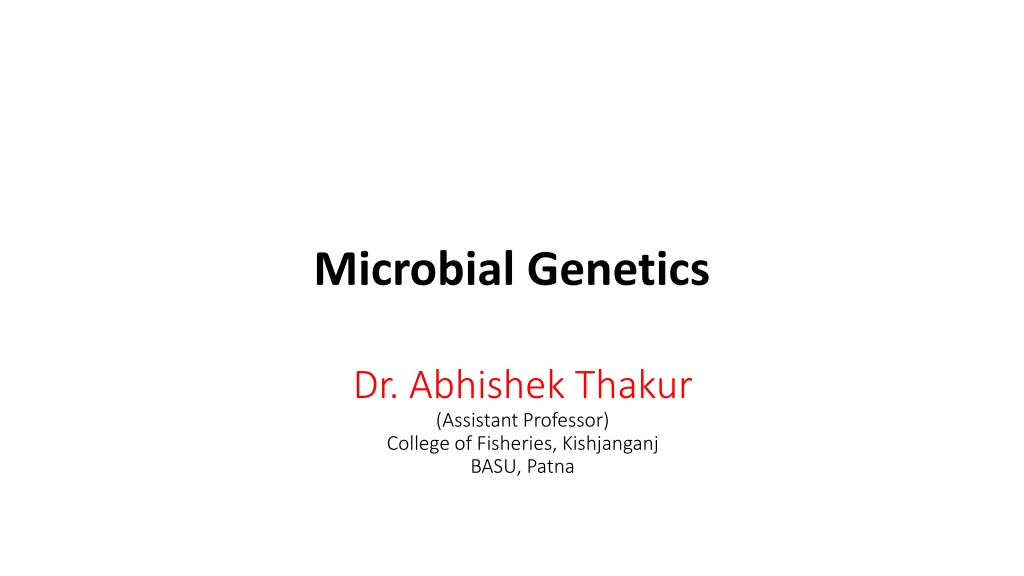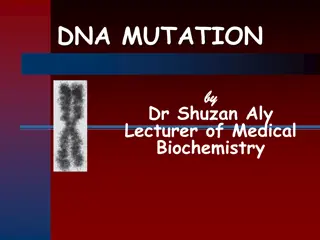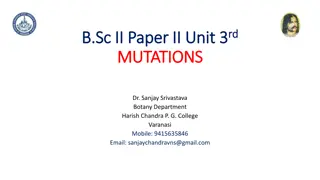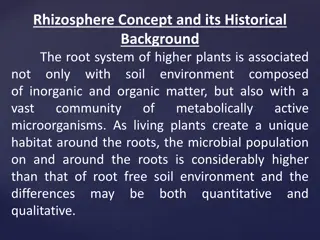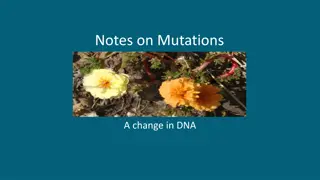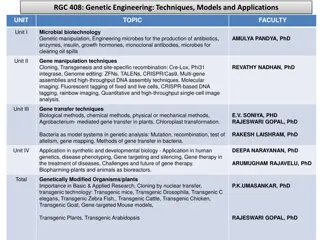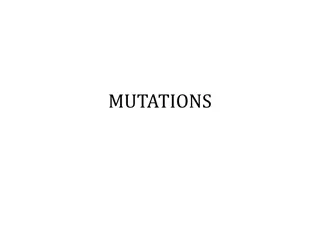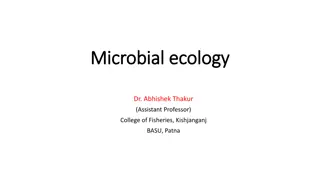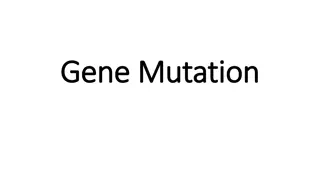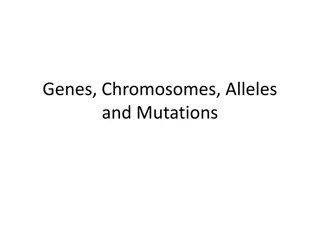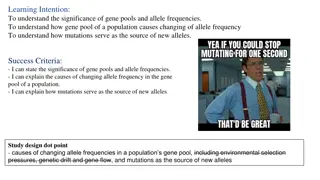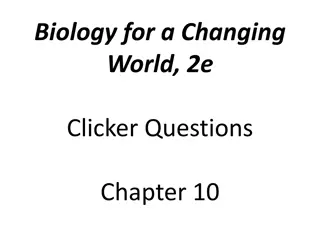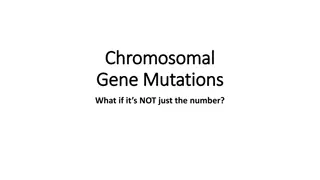Understanding Microbial Genetics and Mutations in Organisms
Explore the world of microbial genetics with Dr. Abhishek Thakur, an Assistant Professor specializing in Microbial Genetics at the College of Fisheries, Kishjanganj, BASU, Patna. Learn about important concepts such as strains, clones, genome, phenotype, genotype, genes, genetic recombination, and mutations. Discover how mutations, whether spontaneous or induced, play a crucial role in genetic variability and evolution in organisms through examples of point mutations, silent mutations, missense mutations, and more. Uncover the impact of mutagens, both chemical and physical agents, in inducing mutations. Enhance your knowledge in this fascinating field through informative visuals and glossary explanations.
Download Presentation

Please find below an Image/Link to download the presentation.
The content on the website is provided AS IS for your information and personal use only. It may not be sold, licensed, or shared on other websites without obtaining consent from the author. Download presentation by click this link. If you encounter any issues during the download, it is possible that the publisher has removed the file from their server.
E N D
Presentation Transcript
Microbial Genetics Dr. Abhishek Thakur (Assistant Professor) College of Fisheries, Kishjanganj BASU, Patna
Microbial Genetics Microbial Genetics Glossary: Strain or clone: A clone is a population of cells that are genetically ideal pure culture. Genome : All the genes present in a cell. Phenotype: Collection of characteristics that are observable. Genotype: Specific set of genes it possess. Gene: A gene is a nucleotide sequence that code for a polypeptide, tRNA or rRNA. Most bacterial genes have at least four major parts promoters, leaders, coding regions and terminator. Genetic recombination: Two separate genomes are brought together in one unit. Mutation: Inherited change in the base sequence of nucleic acid _ alteration in the genetic material.
Mutation Mutation Mutation is an inherited change in the base sequence of the nucleic acid comprising the genome of an organism . A strain carrying such changes is called as mutant. A mutant may differ from its parent strain in genotype (sequence of nucleotides in the DNA of the genome) and sometimes in phenotype (observable properties from its parent) also. A nutritional mutant that has a requirement for a growth factor is called an auxotroph and the wild-type parent from which the auxotroph was derived is called a prototroph.
Mutation Mutation Mutation can be either spontaneous or induced. Spontaneous mutation occurs naturally (natural radiation or due to error in pairing of bases during replication). Mutation involving one or a very few base pairs are referred to as point mutations. Mutation involving change in base pairs without causing change in the amino acid that code for is called silent mutation. (For eg. Change in UAC to UAU would not account for change as both code for tyrosine).
Mutation Mutation Mutation involving change in base pair which codes for a different amino acid is called missense mutation. Eg. (UAC - Tyrosin; AAC asparagine). Some times a mutation may result in premature termination of translation (as the base pair alteration contribute to stop codon TAG - UAG (stop codon) resulting in incomplete protein such is called non-sense mutation.
Mutations Mutations Agents that induce mutations are called mutagens which may be chemical or physical agents. Eg. Nitrous acid (HNO3), Chemical Hydroxylamine (NH2OH), alkylating agents. Physical mutagens UV and ionizing radiation (x-rays) mutagens
Genetic recombination Genetic recombination or Gene Transfer Gene Transfer in Bacteria in Bacteria In prokaryotes, genetic recombination occurs because fragments of homologous DNA from a donor chromosome are transferred to a recipient cell by any of the three following processes. Transformation Transfer of bacterial genes involving free DNA. Transduction Transfer of host genes from one cell to another medicated by a virus. Conjugation Transfer or genes from one cell to another involving cell to cell contact and a plasmid.
Transformation Transformation A cell that is able to take up a molecule of DNA and be transferred is called competent cell. Bacteria differ in the form in which DNA is taken up. In Gram negative bacteria (eg. Haemophilus) only DS DNA is taken up into the cell, however only SS DNA segment is incorporated into the genome. In Gram positive bacteria (Streptococcus sp. and Bacillus) only SS DNA is taken up.
Transduction Transduction Not all phages can transduce and not all bacteria are transducible. In generalized transduction host DNA derived from any portion of host genome becomes a part of the DNA of the mature virus particle in place of the virus genome, which gets integrated into another cell upon entry. In specialized transduction, when a lysogenized cell reverts to lytic cycle, a part of host DNA is exchanged for phage DNA, which replicates and forms phage, which when trasnduced, the new gene gets into another cell.
Conjugation Conjugation Conjugation or mating involves the transfer of DNA from a donor to a recipient by cell to cell contact through the F (Fertility) pilus, followed by recombination within the recipient bacterial cell. Pili are involved in attachment processes. F pili specifically join mating bacteria. When an F pilus joins with the mate, there is a change in plasma membrane permeability so that DNA can move from one cell to another. Bacteria that produce F pili are donors and are designated F+strains.
Conjugation Conjugation During mating, a single strand of donor DNA is replicated, and this copy is transferred to the recipient where the complimentary strand is synthesized. Bacteria are designated Hfr (high frequency recombinant) if the F plasmid DNA is incorporated into the bacterial chromosome. Bacteria lacking F pili are recipient strains and are designated F strains. When F+cell mates with F cell, the F plasmid DNA is copied and transferred from donor to the recipient. This results in F+strains. The F plasmid confers the genetic information for acting as a donor strain.
Bacterial conjugation Bacterial conjugation
Plasmids Plasmids Some bacterial cells contain one or more small circular macromolecules of DNA that store additional specialized information. These are called plasmids (extra chromosomal DNA). Plasmids contain only 1 5% as much DNA as in the bacterial chromosome (roughly about 20 genes) which supplement the essential genetic information contained in the bacterial chromosome.
Plasmids Plasmids Genetic information contained in plasmids can be important, in establishing characters such as resistance to antibiotics and tolerance to heavy metals. Thus the gene products of plasmids may permit the survival of bacteria under conditions that are normally unfavourable for growth and survival. Plasmids can be transferred from one bacterial cell to another, sometimes even from one bacterial species to another.
Protoplasts and Spheroplasts Protoplasts and Spheroplasts When the peptidoglycan layer of the cell wall is digested with lysozyme or when its synthesis is blocked, the cell ordinarily lyses. However, in a hypertonic medium (eg. 20% of sucrose or 0.5M KCl), the cell survives as an osmotically sensitive sphere. With gram-positive organisms this product is free of wall constituents and is called a protoplast. With gram negative bacteria, these osmotically sensitive spheres retain much of the outer membrane and are called spheroplasts.
